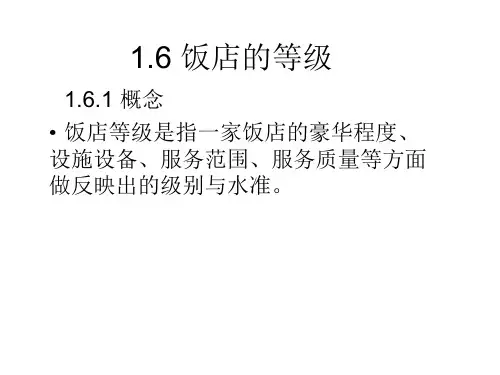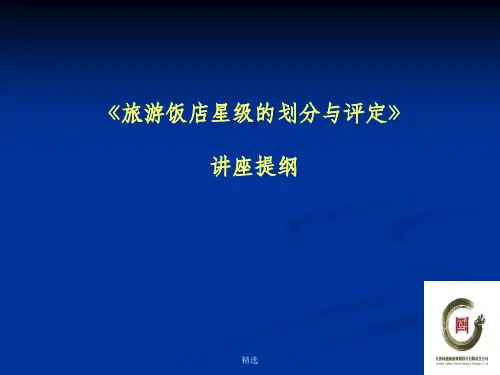英国酒店等级评定标准 PPT课件
- 格式:ppt
- 大小:1.19 MB
- 文档页数:10
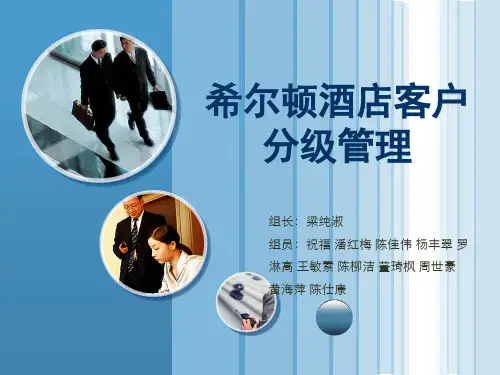


国外饭店划分等级标准纵观世界各国的饭店分级体系,较普遍的出发点是:由公共或私人部门提供有一定公信力的信息作为消费者认知饭店软硬件水平的辅助手段,减少饭店企业营销成本,提升产品质量,便于行业规划和管理。
一、分级目的各国饭店划分等级除了增强消费者认知、有利市场营销、行业监管工具等共同目的之外,各国适应本国经济、社会情况形成的分级体系,有不同的特点:(1)如埃及、希腊、阿曼、黎巴嫩,阿根廷、古巴、希腊等国的饭店分级与饭店房价相联系; (2)阿联酋、斯洛伐克、约旦、摩洛哥、尼日利亚,乌克兰等国的饭店分级与税率“挂钩” ; (3)在荷兰,只有经过星级评定的住宿设施才可称为“饭店”,政府对不同星级的饭店征收不同的房产税。
二、实施主体总体来说,对饭店行业实施分级的主体分为政府、协会和第三方组织三大类别,由此可以将饭店等级分成三种模式:(一)政府部门主导日本、希腊、印度、埃及、土耳其、阿联酋、意大利、罗马尼亚、加拿大等式典型的特别是政府主管饭店业的职能部门,如国家旅游主管部门来执行饭店等级评定的国家。
具体操作上,该模式具有以下特点:第一,评级工作本身是政府干预饭店业发展的一项措施,其微观绩效必须服从于政府的宏观发展规划,是战略式的。
第二,其基础是一整套由“项目—基本指标—修正指标”组成的多维指标模型。
虽然任何指标模型都不可能完美涵盖饭店业的丰富多彩,但为了操作的科学和方便,对指标模型的贯彻依然是评级工作的核心环节。
第三,基本方法是对项目内容进行精确赋值,最终以数量等级的形式反映饭店等级。
第四,科技含量高。
其一是通过政府行政力动员国内外的行业专家,在充分调研和论证的基础上制定和修正指标体系。
其二是不断引入新型检测工具,比如采用网络信息系统收集相关数据。
其三是不断扩大评审专家的选拔范围,多角度掌握信息。
政府部门为主体的饭店等级评定,是政府干预理论在饭店行业管理中的体现,对饭店业的指导和促进作用实实在在。
然而,由于受到政府发展规划的强烈影响,其评定标准会随政府目标的变动而出现较为频繁的变化,评定结果有时会和公众或业界的感受存在一定的差距。
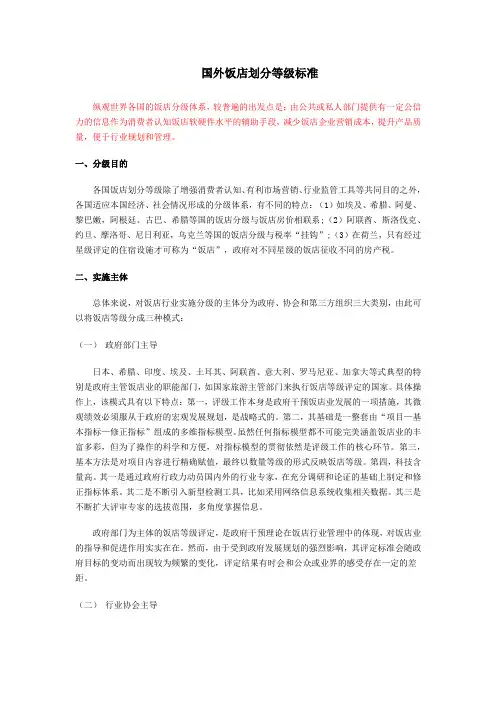
国外饭店划分等级标准纵观世界各国的饭店分级体系,较普遍的出发点是:由公共或私人部门提供有一定公信力的信息作为消费者认知饭店软硬件水平的辅助手段,减少饭店企业营销成本,提升产品质量,便于行业规划和管理。
一、分级目的各国饭店划分等级除了增强消费者认知、有利市场营销、行业监管工具等共同目的之外,各国适应本国经济、社会情况形成的分级体系,有不同的特点:(1)如埃及、希腊、阿曼、黎巴嫩,阿根廷、古巴、希腊等国的饭店分级与饭店房价相联系;(2)阿联酋、斯洛伐克、约旦、摩洛哥、尼日利亚,乌克兰等国的饭店分级与税率“挂钩”;(3)在荷兰,只有经过星级评定的住宿设施才可称为“饭店”,政府对不同星级的饭店征收不同的房产税。
二、实施主体总体来说,对饭店行业实施分级的主体分为政府、协会和第三方组织三大类别,由此可以将饭店等级分成三种模式:(一)政府部门主导日本、希腊、印度、埃及、土耳其、阿联酋、意大利、罗马尼亚、加拿大等式典型的特别是政府主管饭店业的职能部门,如国家旅游主管部门来执行饭店等级评定的国家。
具体操作上,该模式具有以下特点:第一,评级工作本身是政府干预饭店业发展的一项措施,其微观绩效必须服从于政府的宏观发展规划,是战略式的。
第二,其基础是一整套由“项目—基本指标—修正指标”组成的多维指标模型。
虽然任何指标模型都不可能完美涵盖饭店业的丰富多彩,但为了操作的科学和方便,对指标模型的贯彻依然是评级工作的核心环节。
第三,基本方法是对项目内容进行精确赋值,最终以数量等级的形式反映饭店等级。
第四,科技含量高。
其一是通过政府行政力动员国内外的行业专家,在充分调研和论证的基础上制定和修正指标体系。
其二是不断引入新型检测工具,比如采用网络信息系统收集相关数据。
其三是不断扩大评审专家的选拔范围,多角度掌握信息。
政府部门为主体的饭店等级评定,是政府干预理论在饭店行业管理中的体现,对饭店业的指导和促进作用实实在在。
然而,由于受到政府发展规划的强烈影响,其评定标准会随政府目标的变动而出现较为频繁的变化,评定结果有时会和公众或业界的感受存在一定的差距。


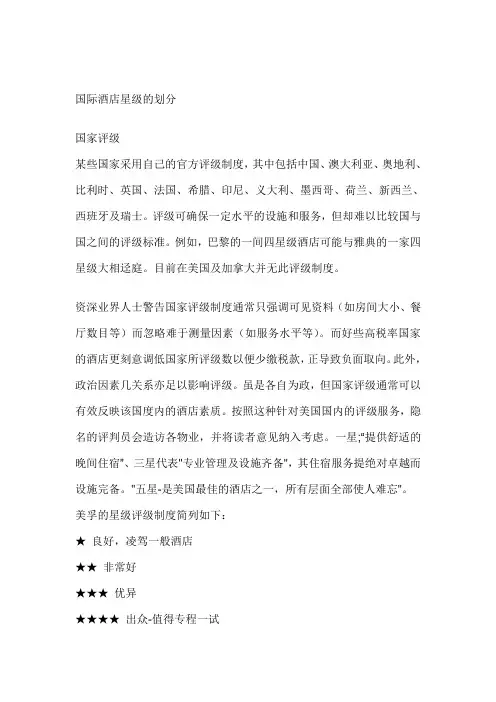
国际酒店星级的划分国家评级某些国家采用自己的官方评级制度,其中包括中国、澳大利亚、奥地利、比利时、英国、法国、希腊、印尼、义大利、墨西哥、荷兰、新西兰、西班牙及瑞士。
评级可确保一定水平的设施和服务,但却难以比较国与国之间的评级标准。
例如,巴黎的一间四星级酒店可能与雅典的一家四星级大相迳庭。
目前在美国及加拿大并无此评级制度。
资深业界人士警告国家评级制度通常只强调可见资料(如房间大小、餐厅数目等)而忽略难于测量因素(如服务水平等)。
而好些高税率国家的酒店更刻意调低国家所评级数以便少缴税款,正导致负面取向。
此外,政治因素几关系亦足以影响评级。
虽是各自为政,但国家评级通常可以有效反映该国度内的酒店素质。
按照这种针对美国国内的评级服务,隐名的评判员会造访各物业,并将读者意见纳入考虑。
一星;“提供舒适的晚间住宿”、三星代表"专业管理及设施齐备",其住宿服务提绝对卓越而设施完备。
"五星-是美国最佳的酒店之一,所有层面全部使人难忘"。
美孚的星级评级制度简列如下:★良好,凌驾一般酒店★★非常好★★★优异★★★★出众-值得专程一试★★★★★全国最佳之一依据国际旅馆评鉴组织的评鉴规定,所谓的国际五星级旅馆,必需符合一千多条的评鉴标准。
我们通常以为饭店建筑气派雄伟,规模宏大,设备豪华,知名度高,就认为是五星级大饭店。
其实并一定如此。
不过我们可从几方面来仔细观察,或许判断是不是标准的五星级旅馆,其正确性会比较高。
★★★★★★★★★费用方面就更没有一个标准了要看各家饭店自己的定价搂★★★★★★★★★多少个星级数?用星表示旅游涉外饭店/酒店的等级和类别,星级用五角星表示,用一颗五角星表示一星级,两颗五角星表示二星级,三颗五角星表示三星级,四颗五角星表示四星级,五颗五角星表示五星级。
旅游国外饭店划分为五个星级,即一星级、二星级、三星级、四星级、五星级。
星级越高,表示饭店/酒店档次越高。
本标准的标志按有关标志的标准执行。
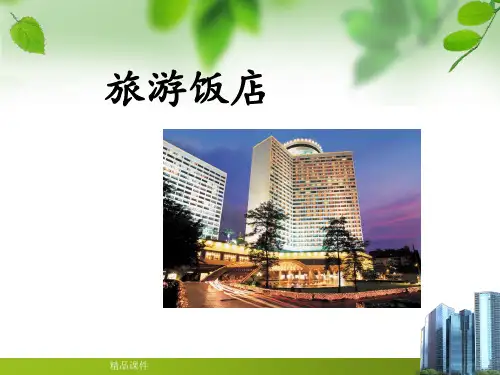
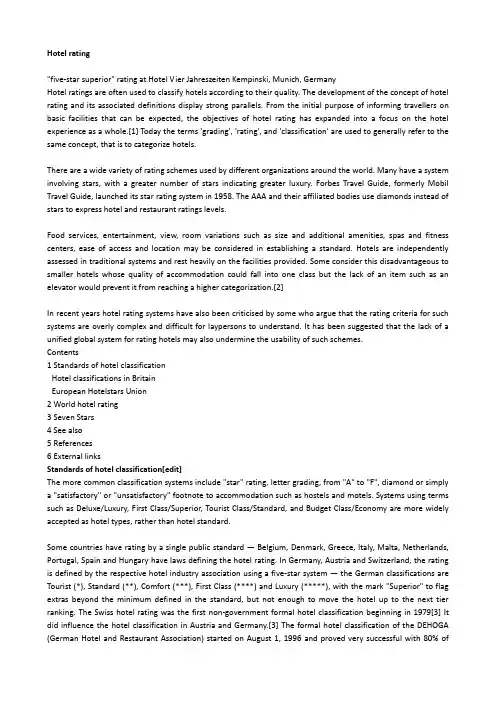
Hotel rating"five-star superior" rating at Hotel Vier Jahreszeiten Kempinski, Munich, GermanyHotel ratings are often used to classify hotels according to their quality. The development of the concept of hotel rating and its associated definitions display strong parallels. From the initial purpose of informing travellers on basic facilities that can be expected, the objectives of hotel rating has expanded into a focus on the hotel experience as a whole.[1] Today the terms 'grading', 'rating', and 'classification' are used to generally refer to the same concept, that is to categorize hotels.There are a wide variety of rating schemes used by different organizations around the world. Many have a system involving stars, with a greater number of stars indicating greater luxury. Forbes Travel Guide, formerly Mobil Travel Guide, launched its star rating system in 1958. The AAA and their affiliated bodies use diamonds instead of stars to express hotel and restaurant ratings levels.Food services, entertainment, view, room variations such as size and additional amenities, spas and fitness centers, ease of access and location may be considered in establishing a standard. Hotels are independently assessed in traditional systems and rest heavily on the facilities provided. Some consider this disadvantageous to smaller hotels whose quality of accommodation could fall into one class but the lack of an item such as an elevator would prevent it from reaching a higher categorization.[2]In recent years hotel rating systems have also been criticised by some who argue that the rating criteria for such systems are overly complex and difficult for laypersons to understand. It has been suggested that the lack of a unified global system for rating hotels may also undermine the usability of such schemes.Contents1 Standards of hotel classificationHotel classifications in BritainEuropean Hotelstars Union2 World hotel rating3 Seven Stars4 See also5 References6 External linksStandards of hotel classification[edit]The more common classification systems include "star" rating, letter grading, from "A" to "F", diamond or simply a "satisfactory" or "unsatisfactory" footnote to accommodation such as hostels and motels. Systems using terms such as Deluxe/Luxury, First Class/Superior, Tourist Class/Standard, and Budget Class/Economy are more widely accepted as hotel types, rather than hotel standard.Some countries have rating by a single public standard — Belgium, Denmark, Greece, Italy, Malta, Netherlands, Portugal, Spain and Hungary have laws defining the hotel rating. In Germany, Austria and Switzerland, the rating is defined by the respective hotel industry association using a five-star system — the German classifications are Tourist (*), Standard (**), Comfort (***), First Class (****) and Luxury (*****), with the mark "Superior" to flag extras beyond the minimum defined in the standard, but not enough to move the hotel up to the next tier ranking. The Swiss hotel rating was the first non-government formal hotel classification beginning in 1979[3] It did influence the hotel classification in Austria and Germany.[3] The formal hotel classification of the DEHOGA (German Hotel and Restaurant Association) started on August 1, 1996 and proved very successful with 80% ofguests citing the hotel stars as the main criteria in hotel selection.[4] This implementation influenced the creation of a common European Hotelstars rating system that started in 2010 (see below).In France, the rating is defined by the public tourist board of the department using a four-star system (plus "L" for Luxus) which has changed to a five-star system from 2009 on. In South Africa and Namibia, the Tourist Grading Council of South Africa has strict rules for a hotel types granting up to 5 stars. In India, the classification of hotels is based on two categories such as “Star” and “Heritage”. Hotels in India are classified by Hotel and Restaurant Association Classification Committee (HRACC), Ministry of Tourism, India.[5]Hotel classifications in Britain[edit]In Great Britain hotels are rated from one-star to five stars. The RAC pulled out of accommodation grading in 2008 so the only grading schemes in operation are those operated by the AA (Automobile Association) and the national tourist boards: Visit England, Visit Wales, the Scottish Tourist Board and the Northern Ireland Tourist Board. The schemes were all 'harmonised' to ensure consistency between the schemes. This applies to all accommodation types apart from self catering that the AA started offering in 2009. The AA criteria are available on its website.[Stated criteria not found: verification needed][6] In addition to the usual black stars (ranging from one (the lowest) to five (the highest), the AA awards red stars to the highest-rated, which are deemed 'Inspectors' Choice'. Each of the national tourist boards have grading explanations on their web sites.European Hotelstars Union[edit]The HOTREC (Hotels, Restaurants & Cafés in Europe) is an umbrella organization for 39 associations from 24 European countries. At a conference in Bergen in 2004, the partners drafted a hotel classification system in order to harmonize their national standards. In 2007 HOTREC launched the European Hospitality Quality scheme (EHQ) which has since accredited the existing national inspection bodies for hotel rating.Under the patronage of HOTREC, the hotel associations of Austria, Czech Republic, Germany, Hungary, Netherlands, Sweden and Switzerland created the Hotelstars Union.[7] On 14 September 2009, the Hotelstars Union classification system was established at a conference in Prague. This system became effective in these countries in January 2010, with the exception of Hungary, Switzerland and the Netherlands, who have chosen later dates for the change. Later more countries have joined the HOTREC hotelstars system: Estonia (2011), Latvia (2011), Lithuania (2011), Luxembourg (2011), Malta (2012), Belgium (2013), Denmark (2013) and Greece (2013).The European Hotelstars Union system is based on the earlier German hotelstars system that had widely influenced the hotel classifications in central Europe, with five stars and a Superior mark to flag extras. Instead of a strict minimum in room size and required shower facilities . a bath tub in a four-star hotel) there is a catalogue of criteria with 21 qualifications encompassing 270 elements, where some are mandatory for a star and others optional. The main criteria are in quality management, wellness and sleeping accommodation.[8] In the catalogue of criteria each entry is associated with a number of points - each Hotelstars level requires a minimal sum of points besides some criteria being obligatory for the level.[9] The minimum requirement for the Superior flag requires the same sum of points as for the next Hotelstars level which however was not awarded due to at least one obligatory requirement being left out.[9]For hotels with three to five stars, the Hotelstars Union will use "mystery guests" to check the service qualityHotelstar Excerpt of the catalogue of criteriaTourist100% of the rooms with shower/WC or bath tub/WCDaily room cleaning100% of the rooms with colour-TV together with remote control Table and chairSoap or body washReception serviceFacsimile at the receptionPublicly available telephone for guestsExtended breakfastBeverage offer in the hotelDeposit possibilitySuperior Tourist The Superior flag is provided when the additional service and accommodation provisions are not sufficient for the next Hotelstar. The bathroom facilities are usually at the same level as for two stars hotels but built from cheaper materials. The cost for regular inspection by independent associations is waived as well.Standard In addition to the single star (*) hotels:Breakfast buffetReading light next to the bedBath essence or shower gelBath towelsLinen shelvesOffer of sanitary products . toothbrush, toothpaste, shaving kit)Credit CardsSuperior Standard The Superior flag is provided when the additional service and accommodation provisions are not sufficient for the next Hotelstar. The Standard-Superior does usually offer the same service level as three-star hotels but the interiors of the hotel are smaller and cheaper so that the three stars were not to be awarded by the inspection body. A two-star superior does not require mystery guesting.Comfort In addition to the standard star (**) hotels:Reception opened 14 hours, accessible by phone 24 hours from inside and outside, bilingual staff . German/English)Three piece suite at the reception, luggage serviceBeverage offer in the roomTelephone in the roomInternet access in the room or in the public areaHeating facility in the bathroom, hair-dryer, cleansing tissueDressing mirror, place to put the luggage/suitcaseSewing kit, shoe polish utensils, laundry and ironing serviceAdditional pillow and additional blanket on demandSystematic complaint management systemSuperior Comfort The Superior flag is provided when the additional service and accommodation provisions are not sufficient for the next Hotelstar. The accommodation facilities for a superior hotel need to be on a modern level and fully renovated which is checked regularly.First Class In addition to the comfort star (***) hotels:Reception opened 18 hours, accessible by phone 24 hours from inside and outsideLobby with seats and beverage serviceBreakfast buffet or breakfast menu card via room serviceMinibar or 24 hours beverages via room serviceUpholstered chair/couch with side tableBath robe and slippers on demandCosmetic products . shower cap, nail file, cotton swabs), vanity mirror, tray of a large scale in the bathroomInternet access and internet terminal"à la carte"-restaurantFirst Class Superior The Superior flag is provided when the first class hotel has a proven high quality not only in the rooms. The superior hotels provide for additional facilities in the hotel like a sauna or a workout room. The quality is checked regularly by mystery guesting of an external inspection service.Luxury In addition to the first class (****) hotels:Reception opened 24 hours, multilingual staffDoorman-service or valet parkingConcierge, page boySpacious reception hall with several seats and beverage servicePersonalized greeting for each guest with fresh flowers or a present in the roomMinibar and food and beverage offer via room service during 24 hoursPersonal care products in flaconsInternet-PC in the roomSafe in the roomIroning service (return within 1 hour), shoe polish serviceTurndown service in the eveningMystery guestingSuperior Luxury The Luxury star hotels need to attain high expectations of an international guest service. The Superior Luxury star is only awarded with a system of intensive guest care.World hotel rating[edit]This section is outdated. Please update this article to reflect recent events or newly available information. (June 2012)There is so far no international classification which has been adopted. There have been attempts at unifying the classification system so that it becomes an internationally recognized and reliable standard, but they have all failed.It has been considered that, as it has been the case in other areas . international accounting standards), hotel classification standards should result from a private and independent initiative. This may be the case of the World Hotel Rating (WHR) project, which notably aims to set international classification standards and rating criteria along the lines of a world star-rating system. It will also establish an information platform on the hotel industry which will be multilingual and multicultural. WHR intends to play a key role in the development of quality hotel services, as well as equitable and sustainable tourism, and the protection of the world's cultural and natural heritage. In addition, WHR will develop labels to promote hotels distinguished by specific features, such as a family and child-friendly disposition. A test period was scheduled for 2010.Seven Stars[editSome hotels have been advertised as seven star hotels. The Burj Al Arab hotel in Dubai was opened in 1998 with a servant for every room - this has been the first hotel being widely described as a "seven-star" property, but the hotel says the label originates from an unnamed British journalist on a press trip and that they neither encourage its use nor do they use it in their advertising. Similarly the Emirates Palace Hotel in Abu Dhabi (open since 2005) is sometimes described as seven star as well, but the hotel uses only a five star rating.The Town House Galleria in Milan, Italy has opened in 2007 and it claims to have a seven star certificate from SGS Italy in 2008.[10] However the SGS Italy (not the official tourism agency) only has five stars in the general hotel stars categorization, with the full title of the certificate being left unknown, just as the renewal process is unknown. Overall, as no traditional organization or formal body awards or recognizes any rating over five-star deluxe,[11] such claims are meaningless and predominantly used for advertising purposes.Historically, luxury hotels have used the membership in The Leading Hotels of the World to document regular inspection on an additional level. This organization had been formed in 1928 and it reorganized in 1971 introducing a world-wide inspection service.。
